|
Today in New Orleans History |
|
|
April 15



 

To receive an update for each day in New Orleans
history, join our facebook page
- Today in New Orleans History
Pharmacist Otis J. René, Jr., born in New Orleans on October 2, 1898, was the the co-author
(with his brother Leon René, and Clarence Muse) of the 1931 song "When It's Sleepy Time Down South", which
became a signature song for Louis Armstrong. During the 1940s, he and Leon established and managed the independent
rhythm and blues labels Exclusive Records and Excelsior Records (1944 to 1951). Excelsior released some of the first
recordings by Nat King Cole. Otis René was noted to have earned $25,000 on one song in 1945, "I'm Lost",
recorded by the King Cole Trio. René had written and produced the song, and distributed the record. He died
on April 5, 1970 in Los Angeles.
It was under construction from 1964 to 1968,
at a cost of $25 million. By 1994, this building was estimated to be worth $300 million. The Rivergate had pedestrian
entrances on Canal and Poydras Streets and Convention Center Boulevard. The South Peters Street elevation was dedicated
to entrance and exit openings for the two-level subsurface 800-automobile parking garage, a long loading dock with two
access doors 20' x 20' to the first floor, and freight elevators. The caption for the postcard (above) reads: The
RIVERGATE, which covers six city squares, located where famed Canal Street meets the Mississippi River, is one of the most
uniquely constructed convention-exhibition halls in the country. Boasting 130,000 square feet of clear, unobstructed space,
with no posts or pillars; it is capable of seating more than 16,000 persons for an assembly or meeting with 733 - 10'
x 10' exhibit spaces, or a combination of both. This 13 1/2 million dollar ($13,500,000) structure will be one of the
nation's newest and finest facilities". Ground breaking ceremonies on December 4, 1964
were followed by the driving of piles and a deep excavation to provide space for the parking garage, mechanical and electrical
equipment, stairs and escalators to move people from subsurface levels up to the first floor, and the tunnel 60' x
750' ($1.3 million). Although the Rivergate was conceived and designed as a convention-exhibition facility, it
was also used as the venue for Mardi Gras balls, high school graduations, and the lying in state of New Orleans native
Mahalia Jackson in 1972). But like the Municipal Auditorium, the Rivergate became obsolete in its usefulness as a convention
and exhibition center. The Ernest N. Morial Convention Center was being planned in 1978. As of 2006, it
has about 1.1 million square feet of exhibit space, covering almost 11 blocks, and over 3 million square feet of total space.
It is the 5th-largest facility of its kind in the United States and would dwarf the old Rivergate. The
City of New Orleans then altered the zoning ordinances to allow construction of a casino at the Rivergate site.
The city issued a call for casino proposals due on August 14, 1992 which required a $50,000 payment
for the privilege of submitting a proposal, half of which was refundable to unsuccessful bidders. On November
5, 1992, Mayor Sidney Barthelemy and the City Council picked Christopher Hemmeter-Caesar's Palace (known as
the Grand Palais group) to lease the city-owned Rivergate site for development of a casino. The lease was signed
on April 27, 1993. Subsequently, the Casino Board awarded the casino operator's license to Harrah's Jazz, a partnership
of Harrah's and the Jazzville group (all local investors). On April 15, 1993, Mayor Barthelemy
and the City Council finalized the selection of Hemmeter as the "developer" -- he later teamed with Caesar's
World of Las Vegas to operate the casino in a renovated Rivergate but soon the Hemmeter-Caesar's group proposed its demolishion
to make way for a new building called Grand Palais. This plan would include a twenty-two-inch deep pond, called
Celebration Lake which would run across the foot of Canal Street, ending at One Canal Place. And there would be a sound
and laser-light show and much more including a recreation of Bernard the colonnaded arcades at the Palace of Fine Arts in
San Francisco. In the end, the only elements of the Grand Palais scheme that were constructed were the "Casino
Support Facility" -- a ten-leve, 2 1/2 block long parking garage) which replaced a group of nineteenth-century buildings
at the corner of Poydras and South Peters Streets and the tunnel linking it to the casino. But everything else fell
through. The official "wall-breaking" ceremony took place on Friday, January 13, 1995.
On this occasion, a back hoe equipped with a claw toothed bucket and a "Harrah's" banner draped on its back
climbed up the steps at the Canal-South Peters Streets entrance and began wrecking the underside of the cement plaster
entrance canopy. Much of the concrete debris was hauled to West End at Lake Pontchartrain to be used as fill for
enlargement of a park off Breakwater Drive. Although only reinforced concrete was supposed to be dumped there, other
debris was included. The nature of the debris stirred environmentalists and their protests stopped the dumping at the
West End site. On October 28, 1999, Harrah's Casino was completed at the foot of Canal Street,
three years behind schedule. From THE RIVERGATE (1968 - 1995) Architecture And Politics -- No Strangers In Pair-A-Dice Already a member of the New Orleans
chapter of the League of Women Voters, Keller began her foray into the world of politics working on voter registration. When
her mother died in 1945, Keller was asked to serve on the local YWCA board, an integrated organization that deeply impacted
her views on race relations. In 1947, seeking to alleviate the housing shortage for New Orleans’s black families, Rosa
and Charles Keller, along with friends and philanthropists Edith and Edgar Stern, financed the construction of Pontchartrain
Park, one of the first middle-class black communities in the country.
Keller expanded her political involvement in the early 1950s when she helped organize the Independent Women’s
Organization, created to support the election of moderate mayoral candidate deLesseps Morrison. When Morrison asked Keller
to serve on the board of the public library system, she readily accepted, becoming the first woman to serve on a citywide
board. Almost immediately Keller brought controversy to her position when she set out to integrate the New Orleans public
library system—a goal she eventually achieved. Keller continued to serve the New Orleans black community in a
variety of ways. She chaired the board of Flint-Goodridge Hospital, a facility that catered to the black community. In this
capacity, she fought for and won access to Blue Cross coverage for the New Orleans black community, and insisted that African
American medical students have access to New Orleans’s medical libraries. Keller also served as president of the New
Orleans Urban League, and on the boards of numerous citywide interracial organizations. In 1953, Keller decided that
it was time the League of Women Voters, an organization she loved, begin the process of admitting black members. With the
help of her progressive peers, she succeeded in integrating the organization in 1955. State laws passed in the wake of the
U.S. Supreme Court’s decision in Brown v. Board of Education, however, forced to the league to resegregate a year later.
Through Keller’s persistence, the league permanently achieved integrated status in 1963. In 1958 Keller led
the fight to desegregate the New Orleans public transportation system, but she considered her efforts to integrate the city’s
public schools as “her war.” Toward this end, Keller helped create Save Our Schools (SOS), an organization dominated
by elite white women in the New Orleans community. During the 1960 New Orleans School Crisis, when the first
black children attended formerly all-white schools, SOS ferried children to and from the integrated schools. They also raised
monies for the black and white families who kept their children in the schools and lobbied the state legislature on behalf
of integrated schools. Much to the chagrin of some family members, Keller also personally financed the legal fight to desegregate
Tulane University in 1963. Through the years, Rosa Keller had no qualms about holding interracial gatherings in her Uptown
home, though it was considered a serious breach of racial etiquette at the time. Keller received numerous honors for
her work on racial issues in New Orleans, including the Times-Picayune Loving Cup Award, which honors New Orleans residents
who have worked unselfishly for the community without expectation of public acclaim or material reward. She also received
an honorary alumnus degree from Newcomb College and an honorary doctorate from Dillard University.
She died in April 15, 1998, in New Orleans. The Keller Family Foundation, established in 1949, continues
to provide monies to sustain and improve the New Orleans community. The Rosa F. Keller Library
& Community Center at 4300 S. Broad was named for her on October 6, 1999 Frystak,
Shannon. "Rosa Keller." KnowLA Encyclopedia of Louisiana. Ed. David Johnson. Louisiana Endowment for the
Humanities, 31 Jan. 2011. Web. 20 Nov. 2013. |
|
|

To receive an update for each day in New Orleans history,
join our facebook page - Today in New
Orleans History.
Analytics |
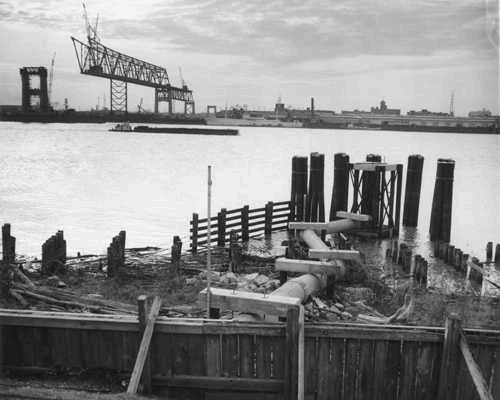
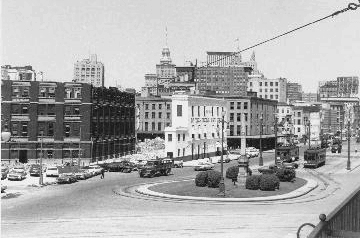
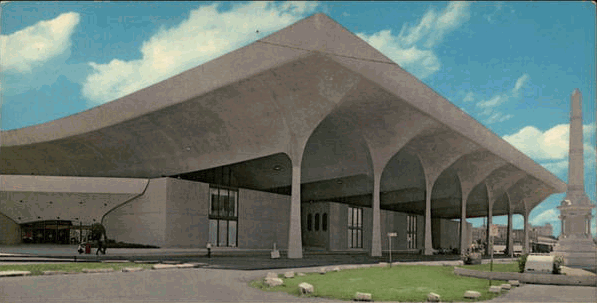 The Rivergate was designed by the local firm Curtis and Davis (Nathaniel Cortlandt Curtis Jr. (1917–1997) and Arthur
Quentin Davis (1920–2011) who had also designed the Thomy Lafon School (1954) and the Louisiana State Penitentiary
at Angola (1956) and would later design the Superdome. The undulating forms of the Rivergate's thin barrel
vaults were not whimsical but are the precise shape necessary to manage the unusually long spans required for the roof
over the column free space below. The cantilevers all around contribute to the stability of the roof structure. The selection
of six temple like bays utilized to the limit the spans between columns; the columns themselves are slender and graceful,
suited to the task of support. The Rivergate, while it stood in New Orleans, was looked upon by many as a significant
example of outstanding national and international contemporary architecture and was compared to the recognized masterpieces
of its period. The most distinguishing feature of the Rivergate was the roof. The 95,500-sq. foot South Hall
was covered by a swooping and sweeping dual curved roof. This reinforced concrete barrel-arched roof design was symbolic
of the rolling Mississippi River which flows about 500 feet from the building. Engineering News Record referred to
these "humpbacked" 1-1/2 catenary curve barrel arches 453 ft. long as having the profile of a whale. The Rivergate
roof was perhaps the longest thin shell concrete roof span that had been constructed at that time. The 34,500-sq. foot
North Hall, later called Penn Hall, in honor of its distinguished and successful manager, Herman Penn, was spanned
by steel trusses 6' deep and covered with a flat roof.
The Rivergate was designed by the local firm Curtis and Davis (Nathaniel Cortlandt Curtis Jr. (1917–1997) and Arthur
Quentin Davis (1920–2011) who had also designed the Thomy Lafon School (1954) and the Louisiana State Penitentiary
at Angola (1956) and would later design the Superdome. The undulating forms of the Rivergate's thin barrel
vaults were not whimsical but are the precise shape necessary to manage the unusually long spans required for the roof
over the column free space below. The cantilevers all around contribute to the stability of the roof structure. The selection
of six temple like bays utilized to the limit the spans between columns; the columns themselves are slender and graceful,
suited to the task of support. The Rivergate, while it stood in New Orleans, was looked upon by many as a significant
example of outstanding national and international contemporary architecture and was compared to the recognized masterpieces
of its period. The most distinguishing feature of the Rivergate was the roof. The 95,500-sq. foot South Hall
was covered by a swooping and sweeping dual curved roof. This reinforced concrete barrel-arched roof design was symbolic
of the rolling Mississippi River which flows about 500 feet from the building. Engineering News Record referred to
these "humpbacked" 1-1/2 catenary curve barrel arches 453 ft. long as having the profile of a whale. The Rivergate
roof was perhaps the longest thin shell concrete roof span that had been constructed at that time. The 34,500-sq. foot
North Hall, later called Penn Hall, in honor of its distinguished and successful manager, Herman Penn, was spanned
by steel trusses 6' deep and covered with a flat roof. 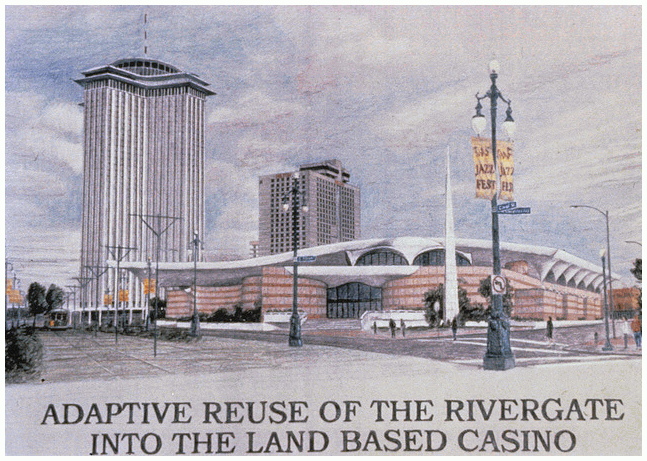 In June 1992, Louisiana House Bill 2010 (Act 384 of the 1992 Regular Session) authorized a land-based casino in New Orleans.
The legislation specifically defined the location of the land-based casino -- the Rivergate site at the foot of Canal
Street. The law did not require the Rivergate to be torn down, and it did not require a new casino to be built.
In June 1992, Louisiana House Bill 2010 (Act 384 of the 1992 Regular Session) authorized a land-based casino in New Orleans.
The legislation specifically defined the location of the land-based casino -- the Rivergate site at the foot of Canal
Street. The law did not require the Rivergate to be torn down, and it did not require a new casino to be built.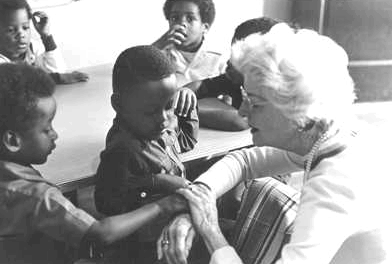 Story by Shannon Frystak
Story by Shannon Frystak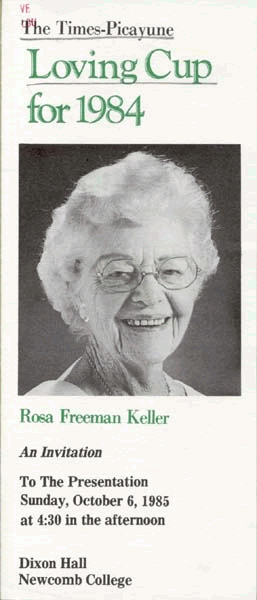 Rosa Freeman was born March 31, 1911, to Alfred Bird “A.B.” Freeman and Ella West. While her
mother descended from a family of southern aristocrats, Rosa’s father was a salesman—a “nobody from nowhere”—until
he made a fortune with his fledgling Coca Cola business. With his success, the family gained entrance into the world of the
New Orleans elite. After high school, Rosa Freeman attended
Rosa Freeman was born March 31, 1911, to Alfred Bird “A.B.” Freeman and Ella West. While her
mother descended from a family of southern aristocrats, Rosa’s father was a salesman—a “nobody from nowhere”—until
he made a fortune with his fledgling Coca Cola business. With his success, the family gained entrance into the world of the
New Orleans elite. After high school, Rosa Freeman attended 
